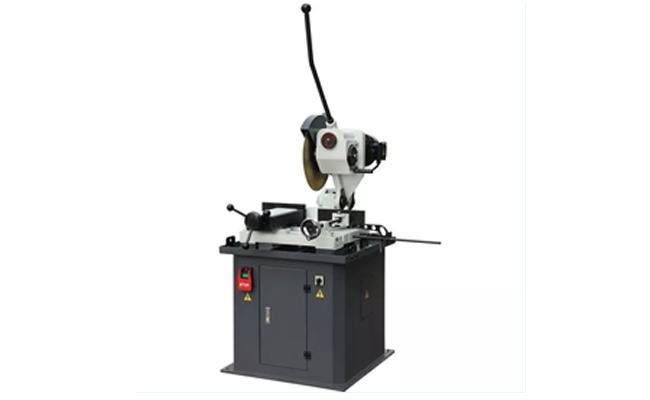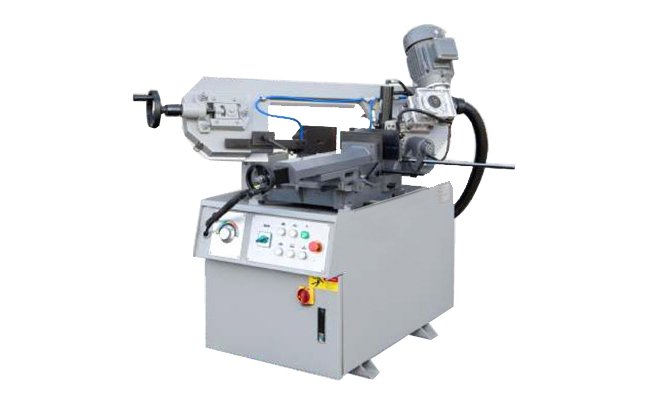1. What is a Metal Band Saw?
A Metal Band Saw is a power saw that features a long, continuous, flexible blade—a band of serrated metal—stretched between two or more wheels. The blade moves in a single, continuous direction, creating a cutting action similar to a jigsaw but on a much larger and more powerful scale. Metal-cutting band saws use bi-metal or carbide-tipped blades and are designed to operate at much lower speeds than their wood-cutting counterparts to manage the heat generated when cutting hard materials.

2. What is a Cold Saw?
A Cold Saw is a circular saw that uses a toothed, hardened steel (HSS) or tungsten carbide-tipped (TCT) blade to cut through materials. The term “cold” refers to the cutting process: the saw transfers the heat generated by cutting to the chips created by the blade’s teeth, while the workpiece and the blade itself remain relatively cool. This is achieved through a rigid, high-precision mechanical design and the use of coolant, which preserves the blade’s temper and ensures a clean, burr-minimized cut.
3. Metal Band Saws
3.1 Cutting Action
The cutting action of a band saw is a continuous, linear motion. The blade is a single, flexible loop that travels over the wheels, with each tooth acting as a precision scraper, removing a small chip of material. Band saws can be either horizontal (for straight, often automated cuts) or vertical (for intricate shapes and contours). The cutting force is relatively low per tooth, but the constant motion allows for efficient cutting of a wide variety of shapes and sizes.

3.2 Advantages
-
Versatility in Material and Shape: Capable of cutting a vast range of materials, from soft aluminum and plastics to tough alloys like titanium and Inconel. They can also handle a wide array of shapes—solid bars, tubes, pipes, and structural beams (I-beams, H-beams).
-
Capacity: Band saws are available in massive sizes, capable of cutting through materials several feet in diameter.
-
Narrow Kerf (Cut Width): The thin blade results in less material wasted as sawdust, improving material yield, which is crucial with expensive metals.
-
Cost-Effective Blades: Band saw blades are generally less expensive than comparable cold saw blades.
-
Ability for Contour Cuts (Vertical Models): Vertical band saws can follow complex patterns and make intricate cuts, a function cold saws cannot perform.
3.3 Limitations
-
Cutting Speed: Generally slower than cold saws for equivalent cross-sections of common materials like steel and aluminum.
-
Surface Finish: The finish is typically not as smooth as a cold saw cut and may require secondary deburring or finishing operations.
-
Geometric Accuracy: While modern CNC band saws are very accurate, the flexible blade can sometimes lead to minor deviations in squareness, especially if the blade is dull or the feed force is incorrect.
-
Burr Production: Typically produces more burr on the exit side of the cut compared to a cold saw.
3.4 Common Applications
-
Cut-to-Length Operations: Cutting long bars of stock (round, square, hexagonal) into smaller blanks for machining.
-
Structural Steel Fabrication: Cutting wide-flange beams, channels, and angles.
-
Pipe and Tube Cutting: Severing and mitering tubing for furniture, handrails, and automotive exhaust systems.
-
Die Making and Prototyping (Vertical): Cutting intricate shapes from metal plates.
4. Cold Saws
4.1 Cutting Action
The cutting action of a cold saw is a shearing, milling-like action. The rigid, circular blade rotates at a high, controlled speed and is fed into the material. Each tooth engages the material cleanly, shearing off a chip. The combination of a high-strength blade, precise mechanics, and flood coolant ensures that the heat is carried away with the chip, preventing work hardening and metallurgical damage to the material.

4.2 Advantages
-
Superior Cut Quality: Produces a clean, mill-like finish with minimal to no burr. The cut surface is often ready for welding or further processing without any additional finishing.
-
High Accuracy and Repeatability: Extremely high dimensional accuracy and perpendicularity. CNC cold saws can hold tolerances within a few thousandths of an inch.
-
Extremely Fast Cutting: For solid bar stock and common profiles within its capacity, a cold saw completes cuts much faster than a band saw.
-
Quiet and Low Vibration: The process is generally quieter and produces less vibration than a band saw, improving the operator environment.
-
Long Blade Life: Because the blade runs cool, the teeth retain their hardness longer, leading to an extended blade life when used correctly.
4.3 Limitations
-
Limited to Straight Cuts: Cannot perform contour or shape cutting.
-
Material and Shape Restrictions: While excellent for solids and some symmetrical profiles, they struggle with very large or irregular cross-sections (like large structural beams) and can be problematic with thin-walled tubing if not supported correctly.
-
Higher Initial and Blade Cost: The machines and their specialized circular blades are a more significant investment than most band saws and their blades.
-
Fixed Blade Size: The capacity is limited by the diameter of the blade. Cutting a larger workpiece requires a larger machine with a larger blade.
4.4 Common Applications
-
High-Volume Production: Ideal for manufacturing environments where thousands of precise, identical cuts are needed daily (e.g., automotive parts, fastener production).
-
Precision Fabrication: Where the cut quality is paramount and must be ready for the next step without post-processing.
-
Mitre Cutting: For creating high-precision, burr-free mitre joints in frames and handrails.
-
Cutting Non-Ferrous Metals: Exceptionally good for cutting aluminum, brass, and copper with a mirror-like finish.
5. Metal Band Saw vs. Cold Saws: At a Glance
6. Factors to Consider When Choosing
6.1 Material Type and Shape
-
Choose a Band Saw if you regularly cut a wide variety of materials, including exotic alloys, or if your work involves large structural shapes (I-beams, wide channels) or large-diameter pipes.
-
Choose a Cold Saw if your work is focused on solid bar stock (round, square, hex) and standard profiles in common metals like steel, stainless steel, and aluminum, where finish is critical.
6.2 Required Cut Quality and Tolerances
-
Choose a Band Saw if the cut face will be machined later or if a “good enough” finish for the application is acceptable.
-
Choose a Cold Saw if the cut face is a finished surface, needs to be welded directly, or must be held to extremely tight angular and dimensional tolerances.
6.3 Production Volume and Speed
-
Choose a Band Saw for lower to medium volume, high-mix environments, or for single, large items that take a long time to cut.
-
Choose a Cold Saw for high-volume, repetitive cutting of similar parts where speed and consistency are paramount to profitability.
6.4 Available Budget
-
Choose a Band Saw if you have budget constraints for both the initial machine purchase and ongoing consumables (blades).
-
Choose a Cold Saw if you have a higher initial capital budget and the superior cut quality can justify the ROI by eliminating secondary operations and reducing scrap.
6.5 Available Floor Space and Operation
-
Band Saws, especially large horizontal models, can have a large footprint but are often simpler to maintain.
-
Cold Saws are typically more compact but require integration with a coolant filtration system, adding to maintenance needs.
Conclusion
There is no universal “winner” in the debate between metal band saws and cold saws. The optimal choice is entirely dependent on the specific demands of your operation. The band saw is the versatile, rugged workhorse, capable of tackling an immense range of challenging cutting tasks. In contrast, the cold saw is the precision specialist, delivering unmatched speed and quality for high-volume production of standard shapes. By carefully weighing the factors of material, quality, volume, and budget, you can select the tool that will deliver the greatest efficiency and value to your workshop or factory floor.
